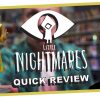Is What Remains of Edith Finch the Best Walking Simulator Ever?
The credits have rolled on What Remains of Edith Finch. Here’s the set-up: a family curse causes every member but one of the Finch family to die in every generation. That left-alive person lives only long enough to keep the family lineage going for another cursed generation. You play as Edith Finch, this generation’s lone surviving member, as you return to your childhood home to learn more about the curse and to, perhaps, escape it. What Remains of Edith Finch is a walking simulator that delivers its story with variety and creativity without ever buckling under the weight of its heavy message. I’ll be reeling from this one for a long time. This could very well be in my top 5 favorite games of all time.
The first, and most consistently impactful visual you experience in the game is the Finch house itself. Most immediately striking about The Finch house’s exterior is the seemingly impossible construction, perceived even in silhouette. It simply looks too top-heavy to stay upright. The family matriarch, Edie Finch, believes in the curse so fully that she doesn’t allow bedrooms to be reused. Instead, after each death, the room is boarded up and new rooms are added to the house. Every birth and every marriage sprouts new rickety staircases leading to narrow antechambers that bloom into unstable bedrooms. The house itself is like a tree with as many nodes as there are doomed Finch souls.
The architectural stories that make up this house seem to defy stability in the same way the stories of the family curse do. It’s a lovely play on words. The player is never really certain if the curse is actually real or if the progenitors of the curse are simply insane. Everything is one perspective shift away from crumbling. That type of tension is rare for a walking simulator which is strange because the very nature of a walking sim–a genre that’s so overtly controlled–should be a perfect vehicle for tension. Hopefully What Remains of Edith Finch gives the genre permission to explore tension a bit more.
As we move from the outside of the house to the inside, we learn that the interior is no less confusing. Books dominate the player’s periphery, like the house itself is constructed using books as bricks. Even the spoken dialog is matched to the perspective of the house. The Finch house is a beautiful melding of a Borgesian library labyrinth with Mark Z.Danielewski’s titular House of Leaves. If you are unfamiliar with Borges or Danielewski, read them immediately. Links to the relevant works in the description below.
What Remains of Edith Finch’s core message is that words are important and confusing, enough so that they can define–or redefine–a death based on the motivations of those wielding the words. Where one person may be satisfied with a simple medical diagnosis–for example, Molly ate poison berries and died–others may prefer something magical–Molly possessed a giant sea monster and led it to her bedroom where the monster ate her. The former is sterile and believable. The latter, though more mysterious and perhaps more gruesome, does offer at least a way for the family to control the chaos, to own it, and in that way be brought together by the tragedy. It’s here that the game reveals it’s heart.
While playing What Remains of Edith Finch the player is constantly asked to choose between those two narratives, the sterile and plausible vs the magical and binding. Ultimately, you as the player get to decide what you believe, in much the same way Edith and the rest of the Finch’s have to navigate the possibility of a curse vs the probability of no curse.
This open-ended approach, one that puts the burden of interpretation on the player would be awful if the game weren’t executed so well. Oh, but it is executed so well. Each family member’s death is explored in incredibly imaginative ways. For example, Barbara Finch is a washed up childhood horror movie actress who was killed during a home invasion. Her story is explored by way of an interactive Tales from the Crypt style comic book. Lewis Finch died in a fish cannery. The sterile and plausible version: he got distracted and fell into a fish grinder. The magical and binding version: his imagination created such a powerful proxy that real life–and the real danger associated with it–couldn’t compare the glamor of his fiction. His death then becomes almost noble, as the avatar he feels comfortable with outlives the real Lewis that he simply endured up until the moment of his death.
This Lewis Finch scene, perhaps one of the most effective of the game, has the player controlling both realities simultaneously, the right analog stick controlling the day job monotony with the left analog stick controlling Lewis’s fictional avatar.
And of all the Finch’s, I relate to Lewis the most. I, like Lewis, used to commandeer my day job to focus on fiction. I used to think of my job as just something I did between writing sessions. Most of my first novel, Stranger Will, was written on a clipboard in the produce cooler of a grocery store.
Read these:
- Jorge Luis Borges “The Library of Babel” and “The Garden of Forking Paths” found in Collected Fictions: https://www.amazon.com/Collected-Fictions-Jorge-Luis-Borges/dp/0140286802/
- Mark Z. Danielewski’s House of Leaves: https://www.amazon.com/House-Leaves-Mark-Z-Danielewski/dp/0375703764/
- Family Guy “Road to Europe” http://familyguy.wikia.com/wiki/Road_to_Europe
Music Credits
- 8bit Dungeon Level Kevin MacLeod (incompetech.com), Licensed under Creative Commons: By Attribution 3.0 License, http://creativecommons.org/licenses/by/3.0/
- Bit Shift Kevin MacLeod (incompetech.com), Licensed under Creative Commons: By Attribution 3.0 License, http://creativecommons.org/licenses/by/3.0/


